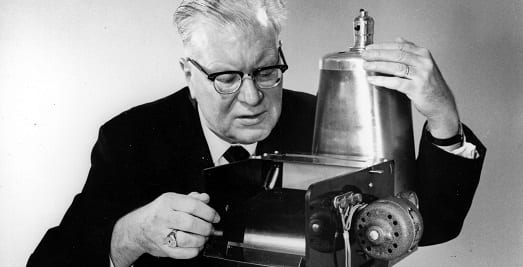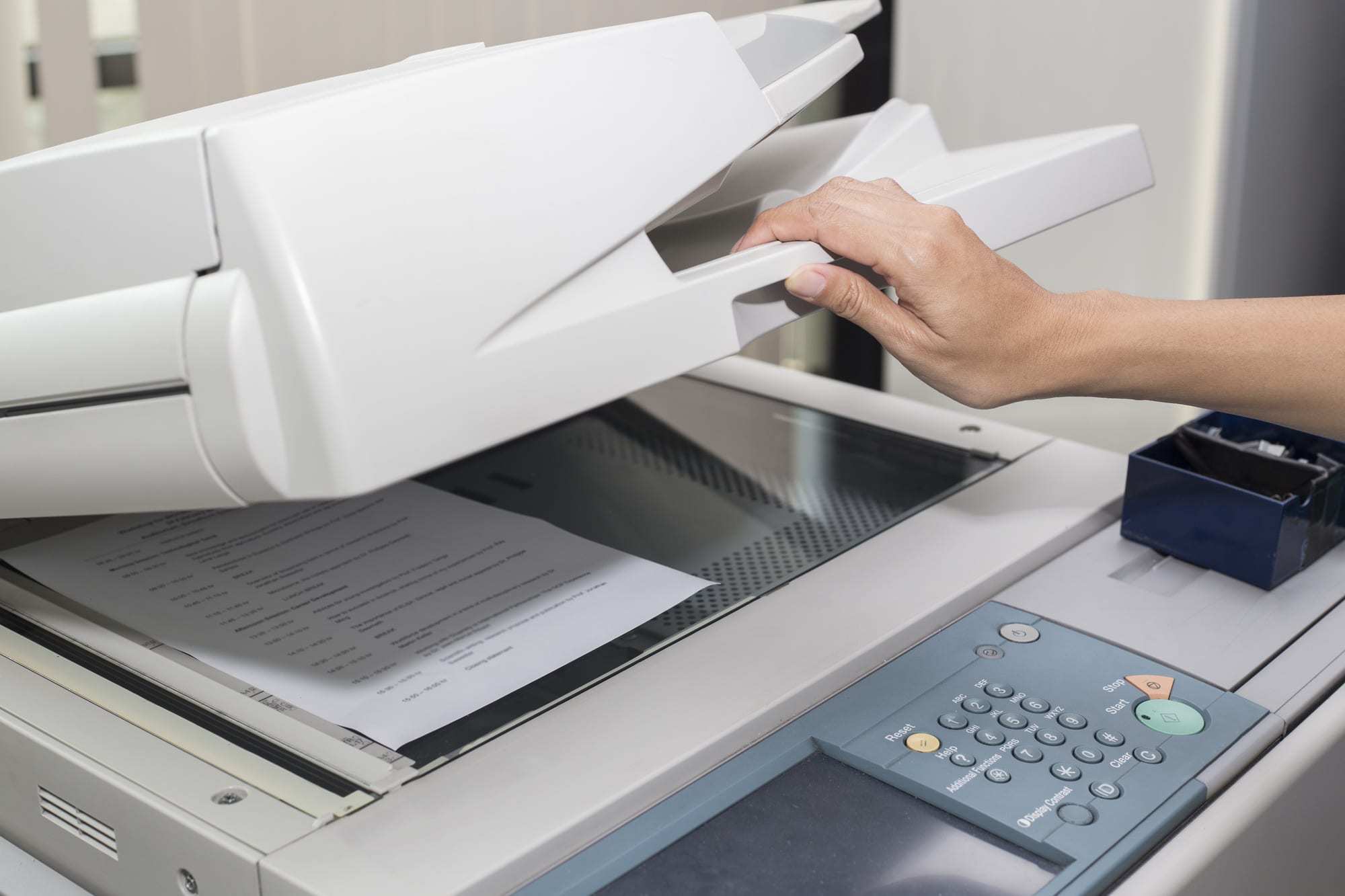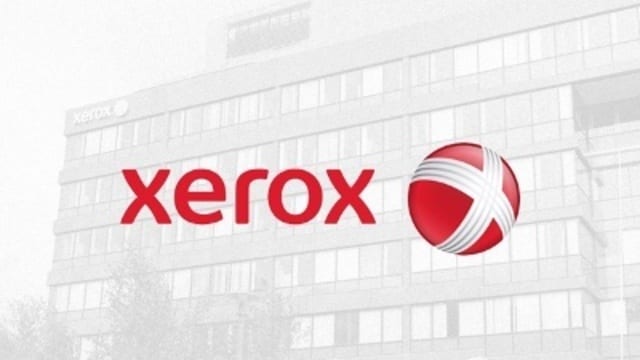The History of the Copy Machine – Starting in 1938
Do you work in an office? Then you’re likely familiar with the photocopier—good copiers and bad ones, and maybe even curious about its history.
Today, we’re taking a quick look at the evolution of the copy machine. Next time you’re waiting for your copies, impress your colleagues with some fascinating facts about this game-changing device!
Humble Beginnings
 There exist many millions of photocopiers today. But before World War II, the technology that transformed every office in the world was just a kitchen experiment in a nondescript apartment in Queens.
There exist many millions of photocopiers today. But before World War II, the technology that transformed every office in the world was just a kitchen experiment in a nondescript apartment in Queens.
Physicist and inventor Chester Carlson used a handkerchief to generate static electricity on dry powder to create the first photocopy on October 22, 1938.
Carlson’s first experiments were literally explosive. In his attempt to innovate, he caused many sulfur fires, which made the entire apartment block smell like rotten eggs! He once almost burned his apartment down.
These were hard times for the inventor, who developed spinal arthritis. Despite the health problems, he pressed on with his experiments while studying law and keeping a regular job. Carlson leveraged his background in law to patent his experiments, filing his first preliminary patent application in late 1937.
The Breakthrough
A year later, Carlson’s wife was fed up with the constant fires. The inventor was racing against other scientists and big companies who all tried to find a viable method to copy files. He rented a room in a nearby house and hired an Austrian physicist as his assistant.
Carlson’s main antagonist was the Haloid Company. Haloid developed photographic techniques that worked well but required expensive chemicals to produce. So, he had to find something cheaper and faster than the precursor of Kodak photos.
On October 22, 1938, Carlson has his major breakthrough. He first wrote the words “10.-22.-38 ASTORIA.” on a microscope slide. Then, rubbed a cotton handkerchief on a zinc plate with a sulfur coating, applying a static charge. With a few more inexpensive manipulations, he managed to transfer the image of his message to a sheet of wax paper.
The world’s first photocopy has been made!
After a few more tests to ensure he had done it, Carlson took out his assistant for lunch to celebrate the invention of electrophotography.
 From Xerography to Xerox
From Xerography to Xerox
Carlson claimed the patent for what would become photocopying technology but did little with it for more than 8 years. In December 1946, he signed the first agreement to license electrophotography technology for commercial use. The agreement was between Carlson, the Haloid Company, and Battelle, another tech giant of the time.
At that time, Haloid introduced the term xerography to distinguish electrophotography from the more conventional photographic technologies. Carlson didn’t like the term, which came from combining the Greek words xeros (dry) and grapho (to write).
The term was widely popular, and with the first commercial xerography machines on the market, Haloid changed their name to Haloid Xerox. Yes, that same Xerox we all know today.
Xerox 914: The First Modern Photocopier
After numerous attempts and limited early prototypes, the first modern photocopier finally hit the market in 1959.
The Xerox 914 was the first machine that closely resembles today’s photocopiers. It was massive by modern standards, slow, and weighed a staggering 650 pounds. Yet, despite its size and speed, it was a groundbreaking innovation.
The Xerox 914 functioned by placing an original document on a glass surface and pressing a button, producing a single copy on plain paper. However, its launch wasn’t entirely smooth—one of the first two Xerox 914 units actually caught fire! Fortunately, the second one worked flawlessly.
The machine was an instant success. A Xerox commercial from that era featured a woman enthusiastically saying:
“I make perfect copies of whatever my boss needs by just turning a knob and pushing a button. Anything he can see, I can copy in black and white on ordinary paper. I can make seven copies a minute. … Sometimes my boss asks me which is the original, and sometimes, I don’t know.”
Between 1959 and 1961, Haloid Xerox’s revenue nearly doubled. The machine’s biggest selling point? It could make copies without damaging the original—assuming, of course, it didn’t catch fire!
Another major advantage of the Xerox 914 was its affordability. Unlike earlier duplicating methods, it required no special paper or trained operators, making it accessible to businesses of all sizes. Haloid Xerox capitalized on this by offering the 914 through affordable rental plans, effectively outpacing competitors and dominating the market.
The Xerox 914’s success led the company to officially change its name from Haloid Xerox to Xerox Corporation in 1961.
Since then, the core technology of photocopying has remained largely unchanged. The same principles behind Chester Carlson’s invention continue to power modern printers and digital scanners.
In the early 2000s, many predicted that photocopiers would become obsolete with the rise of computer printers. With nearly every office equipped with printers, some believed standalone copiers would fade into irrelevance.
Yet, nearly two decades later, photocopiers remain widely used, and sales continue to thrive. Many modern machines now blur the lines between copiers and printers, proving that the demand for efficient document reproduction is far from over. The future of photocopying remains bright!
Now That You Know the History of the Copy Machine…
Knowing the history of the copy machine makes you appreciate commercial photocopiers even more. Here at Commercial Copy Machine, we provide FREE service to help businesses across the US get awesome pricing on high-quality office copy machines.
We are the nation’s #1 hub for commercial copier supplier matching. Check out our site for product comparisons, buying advice and general tips on how to make the most out of your photocopiers.

 From Xerography to Xerox
From Xerography to Xerox